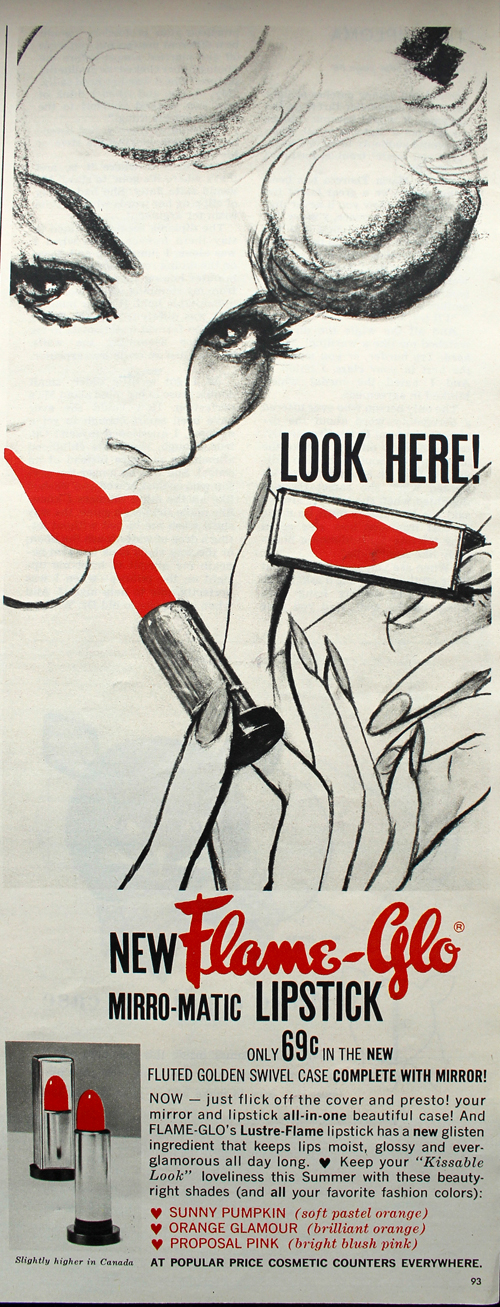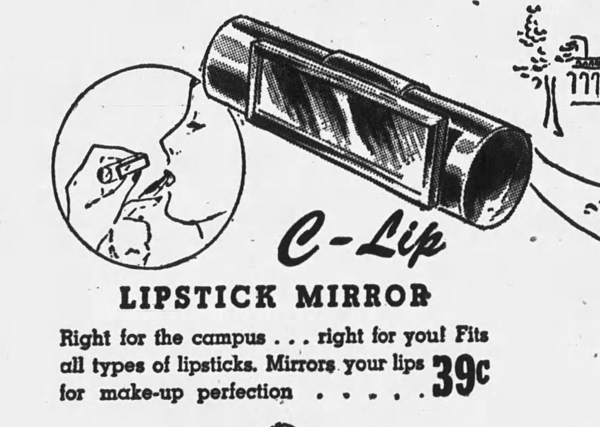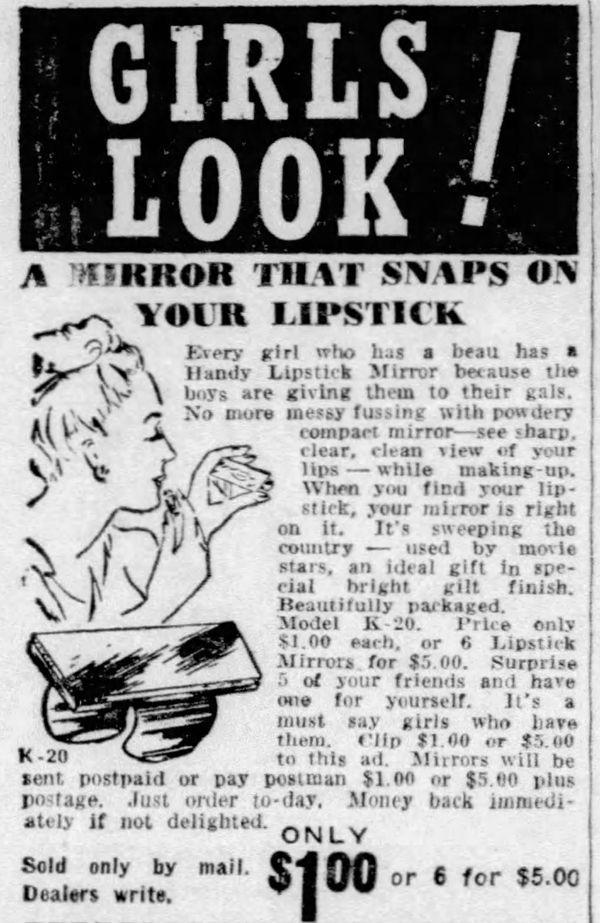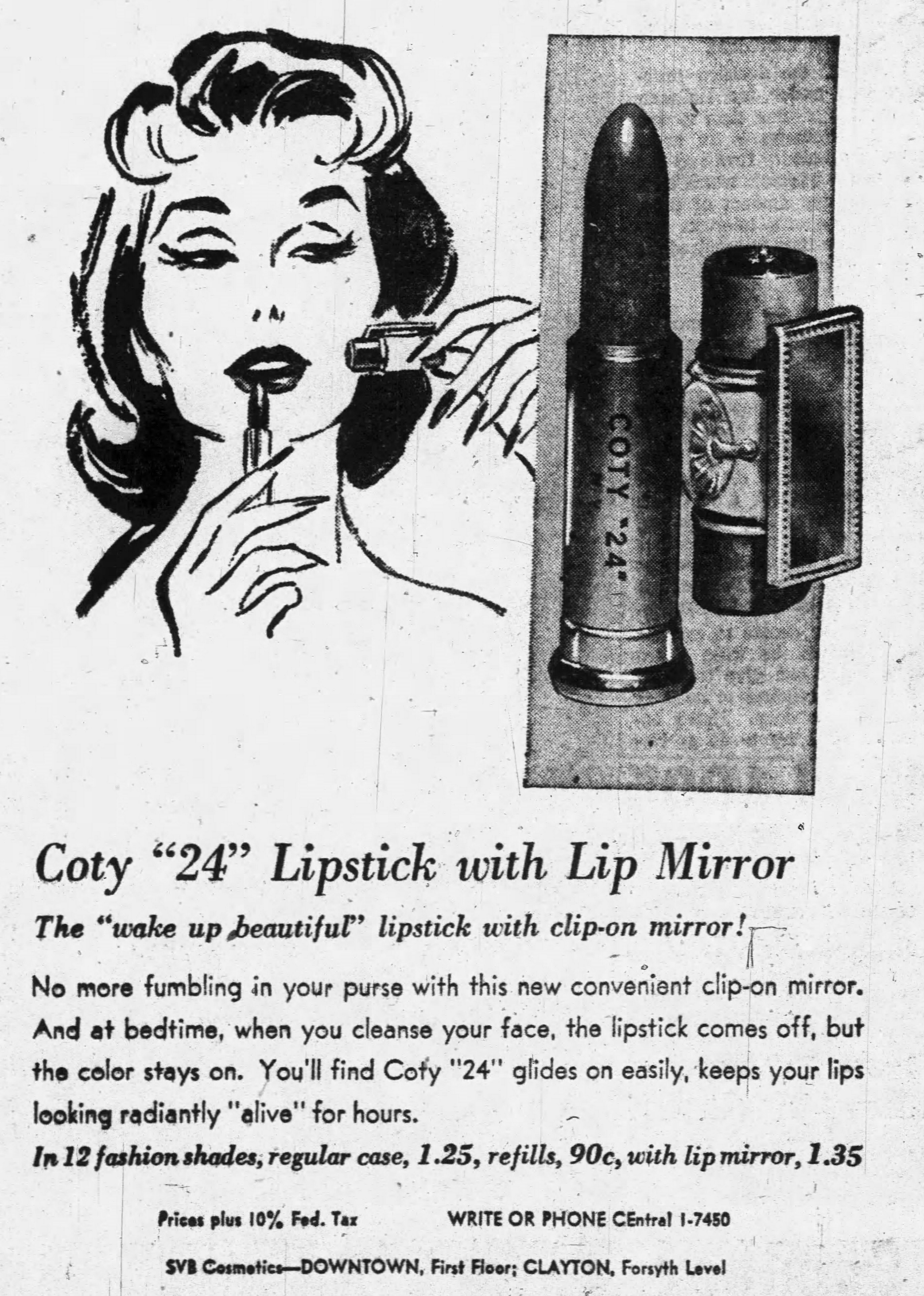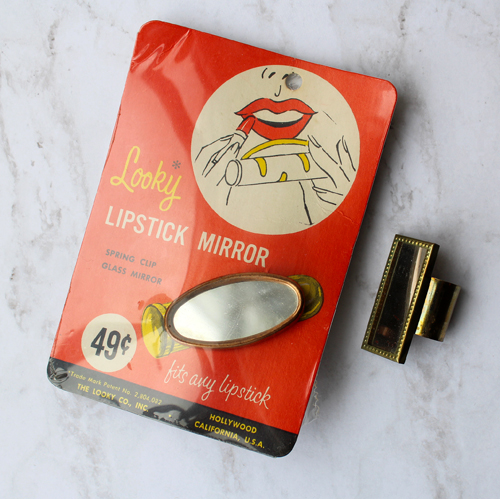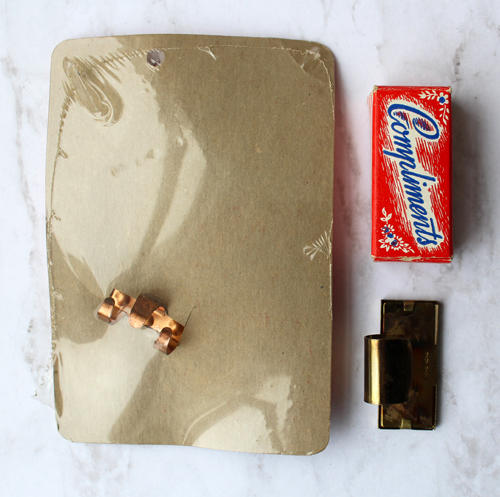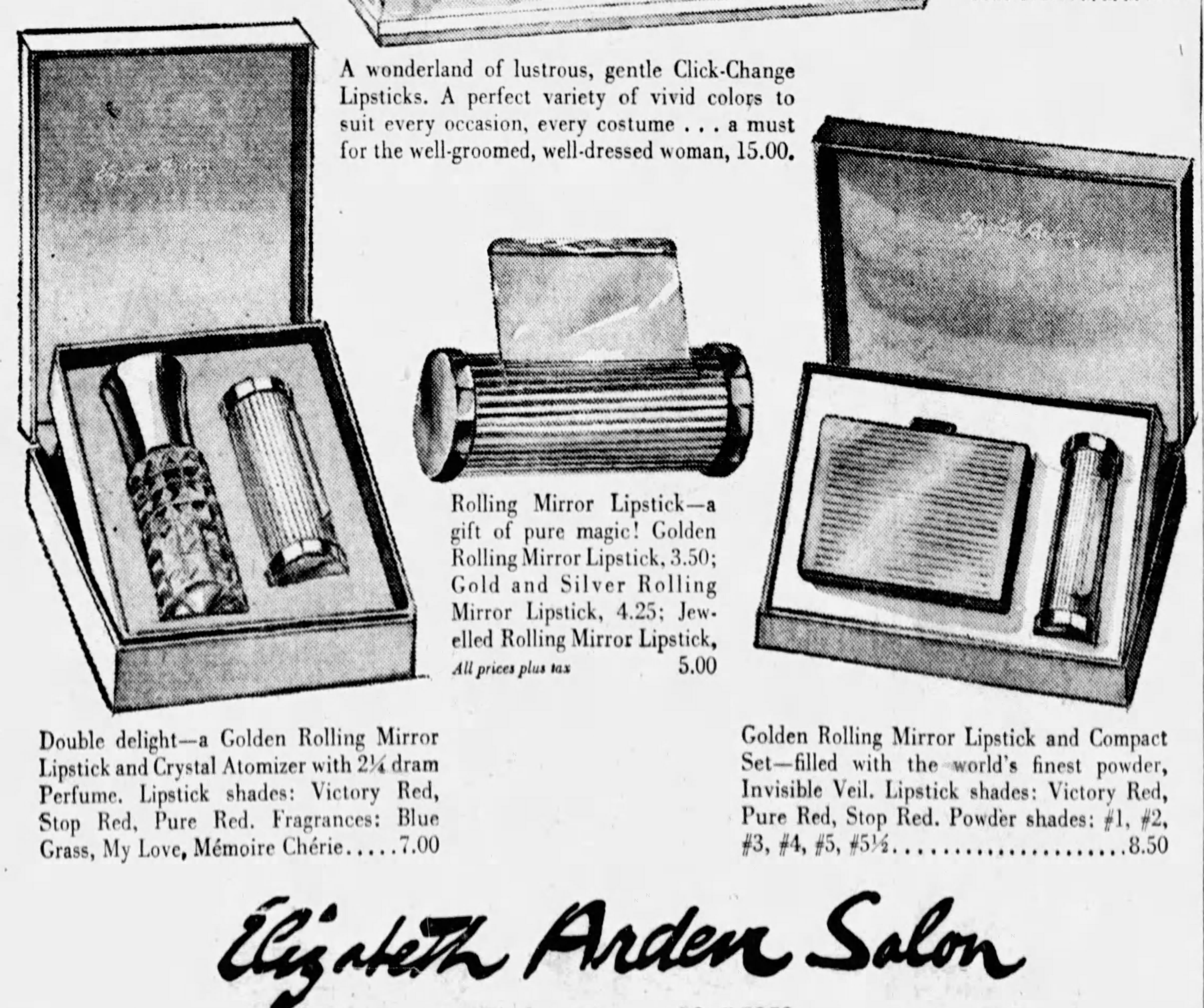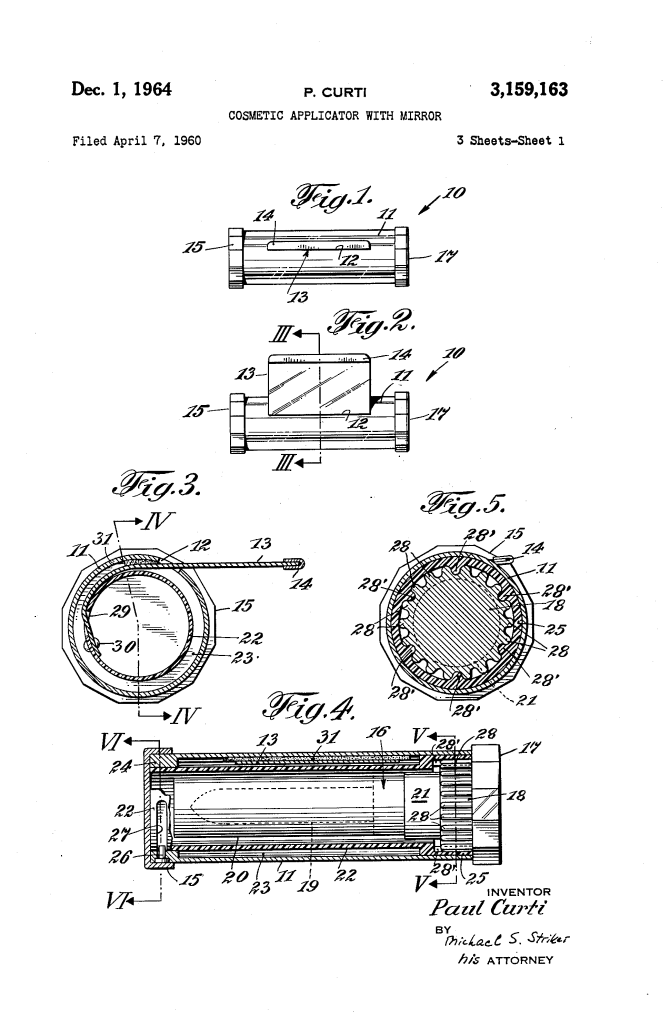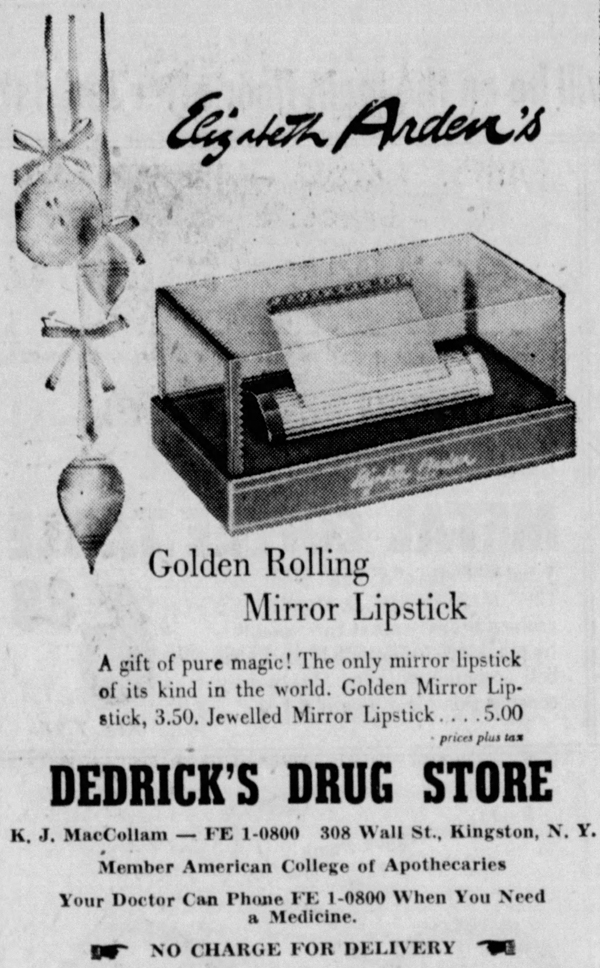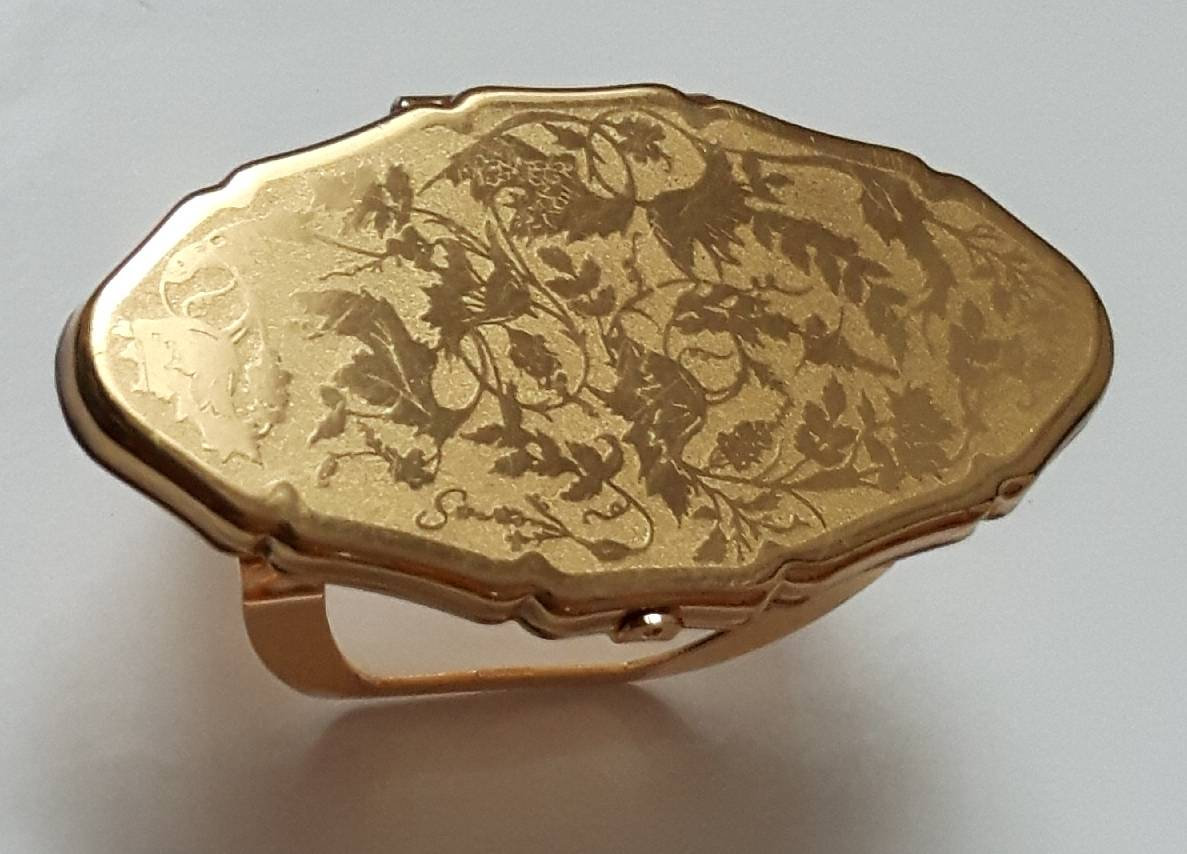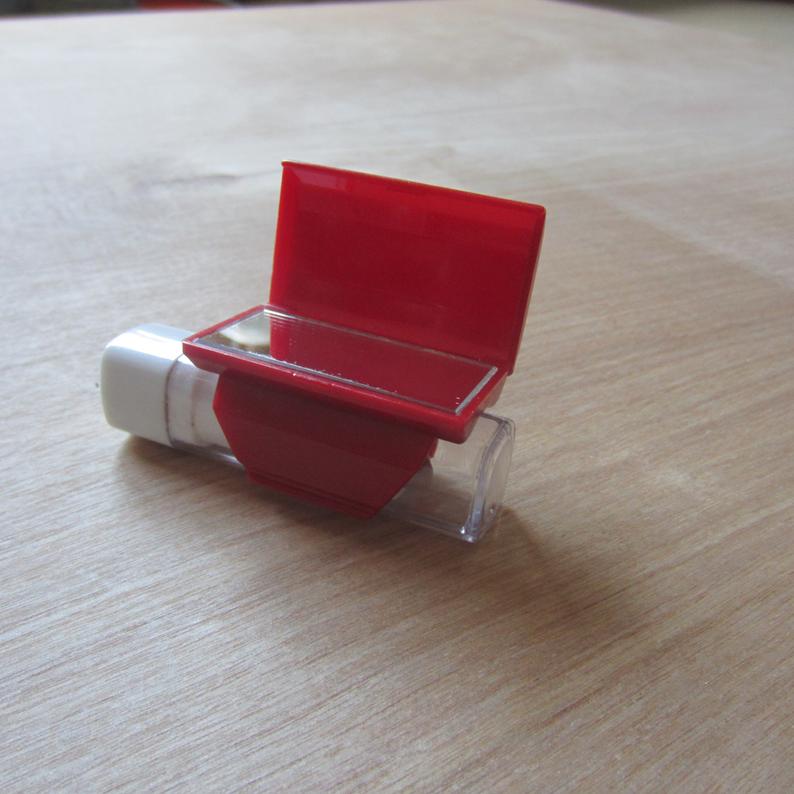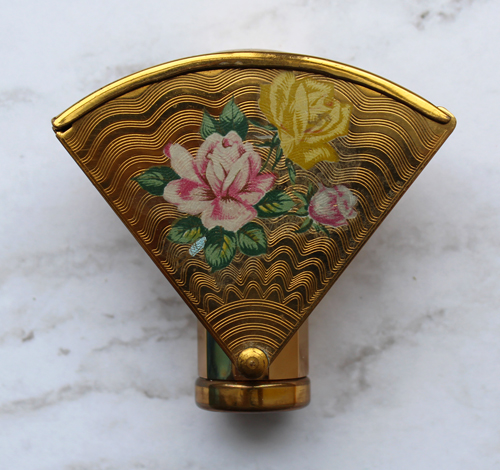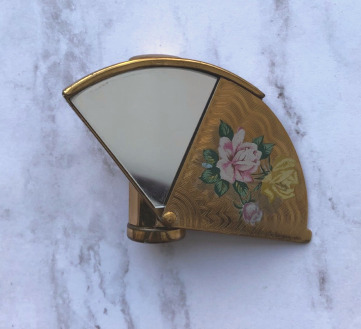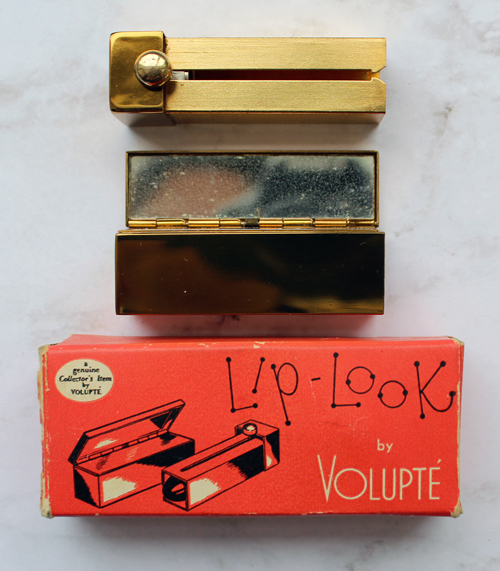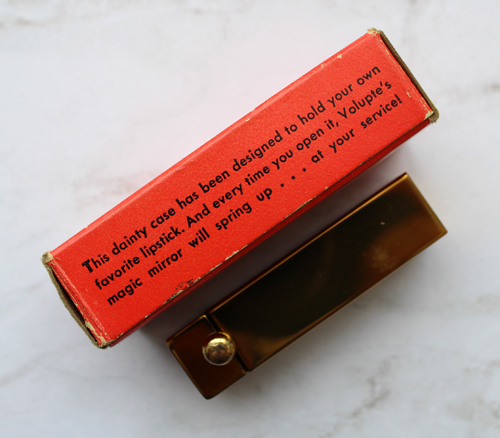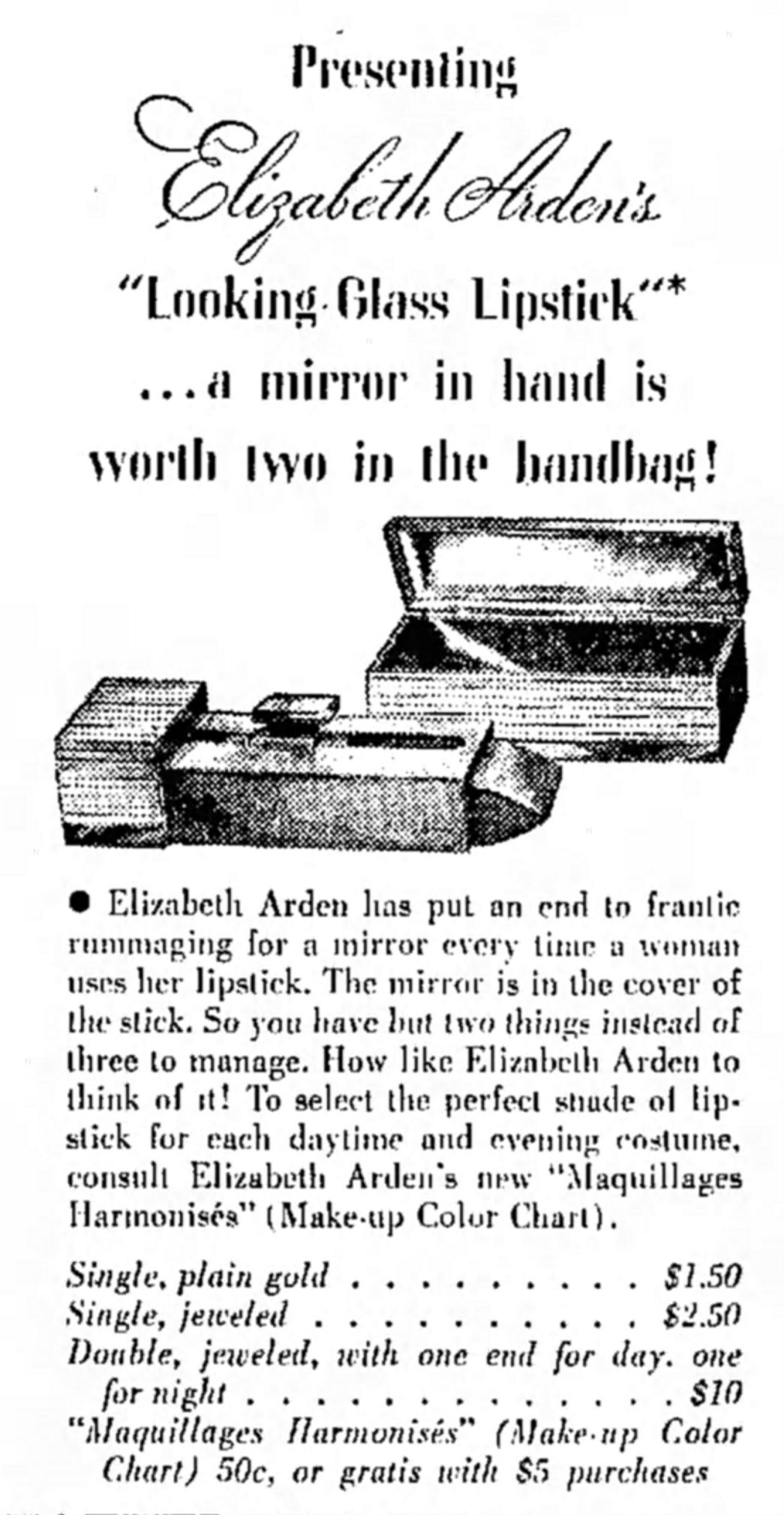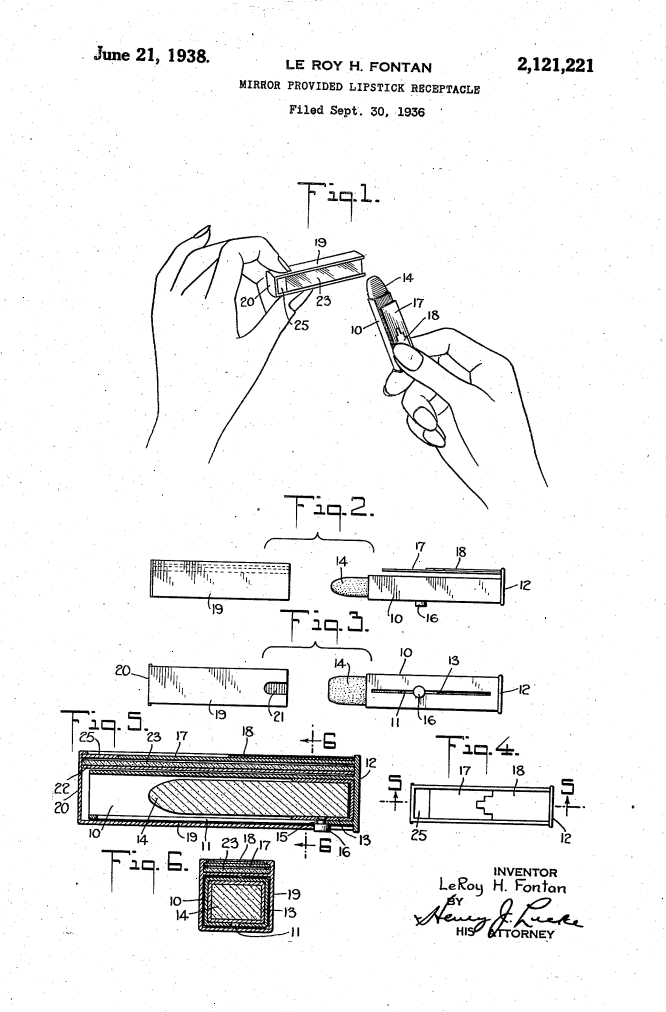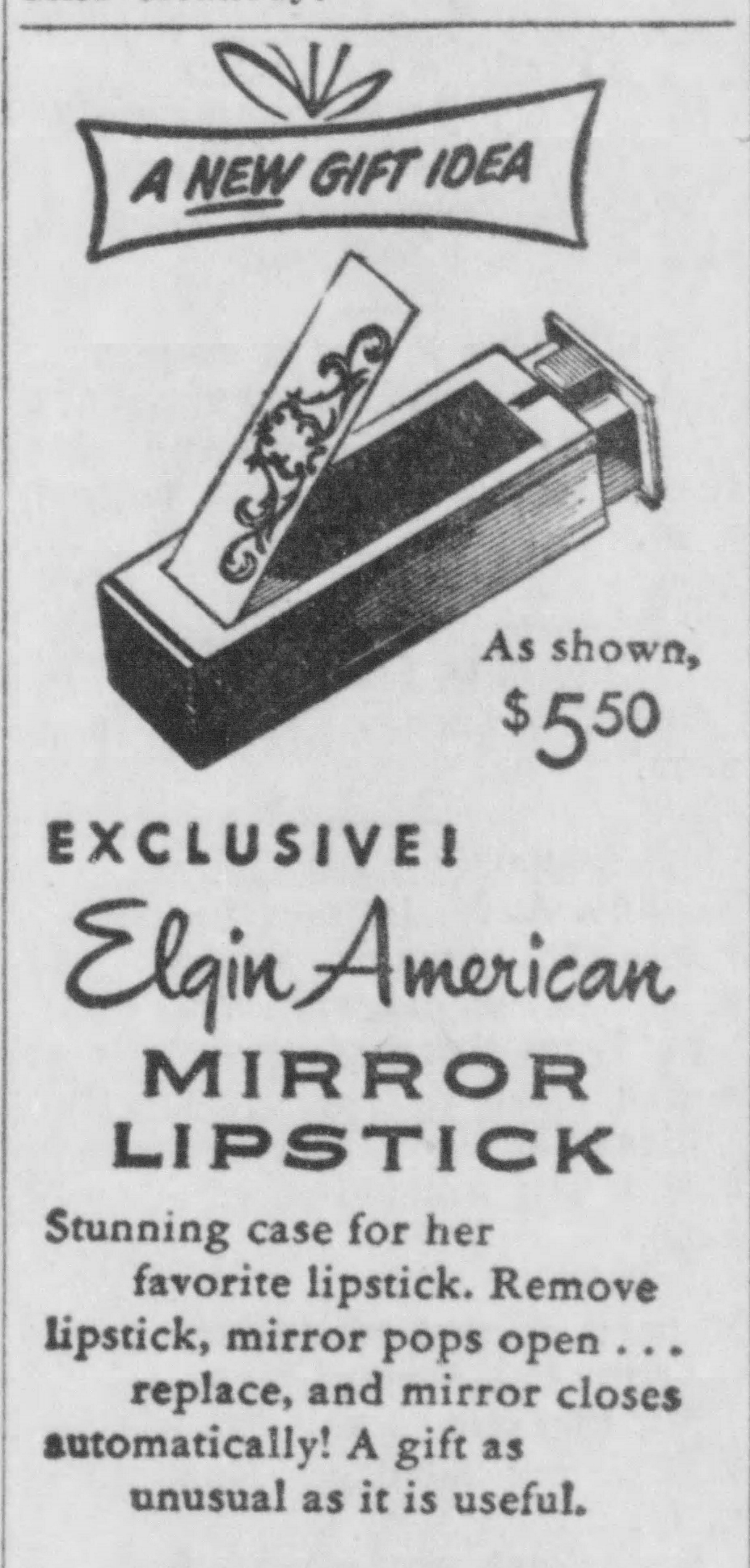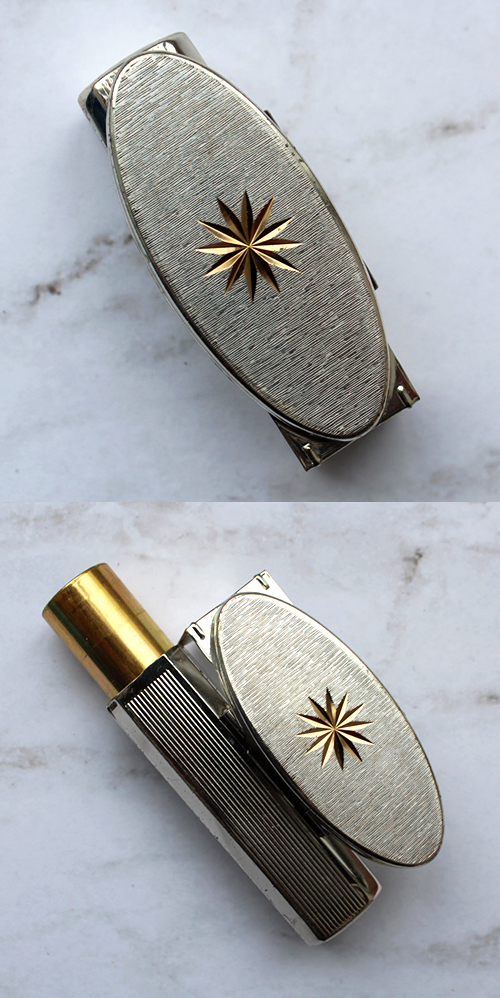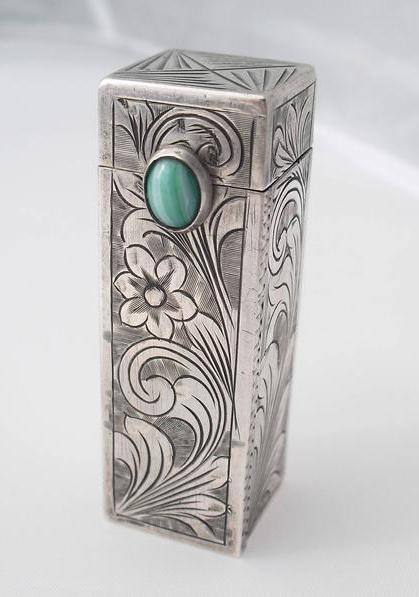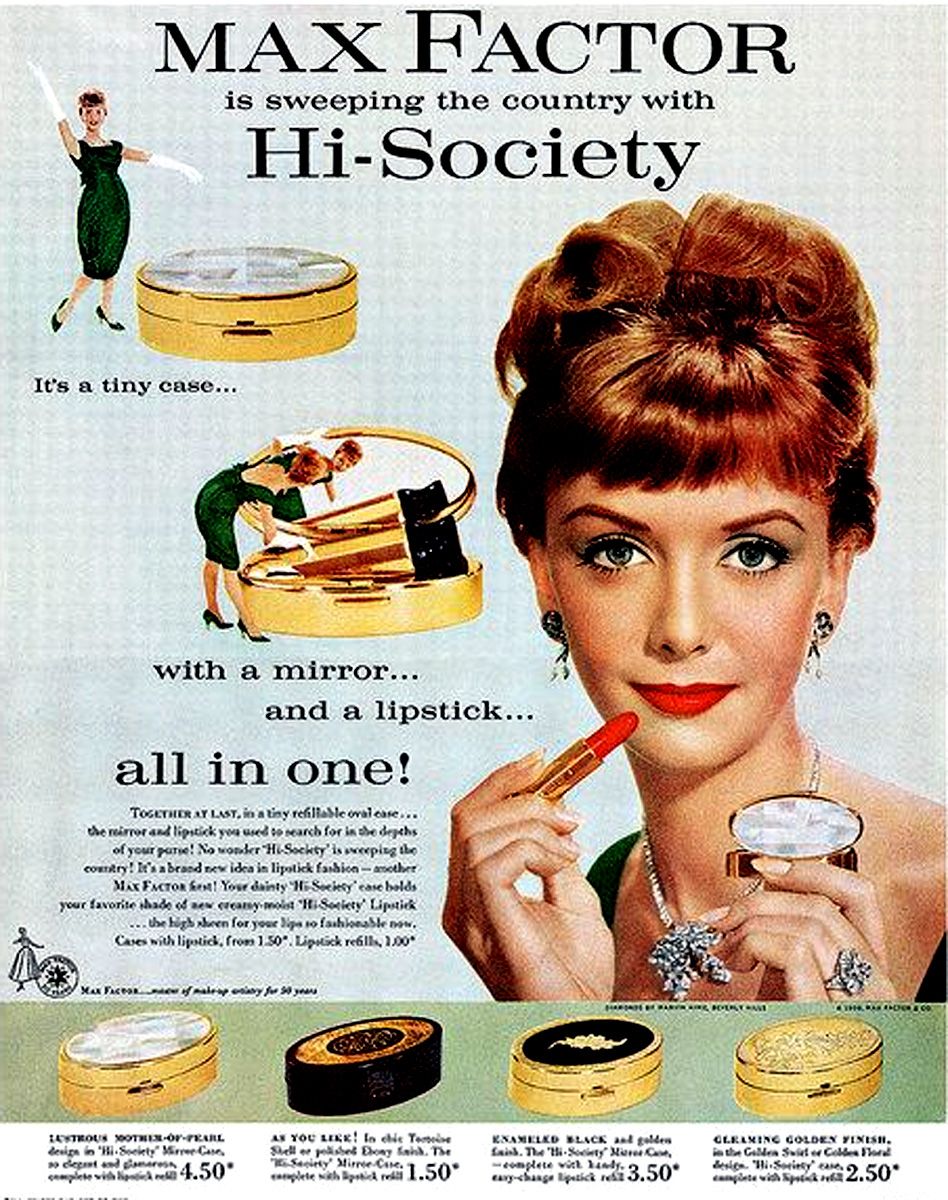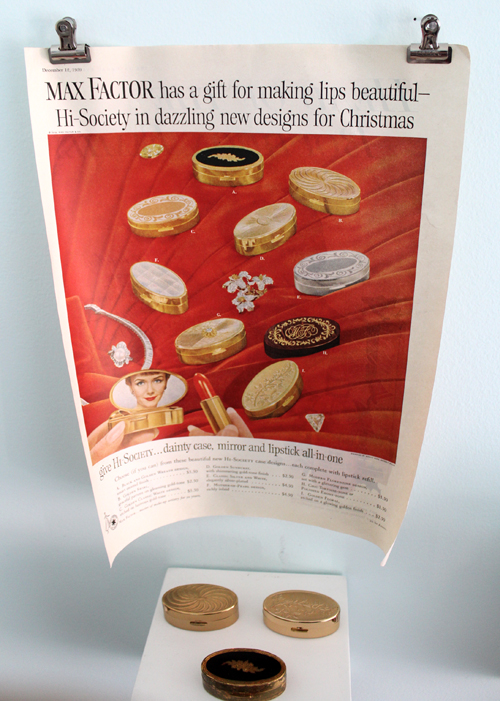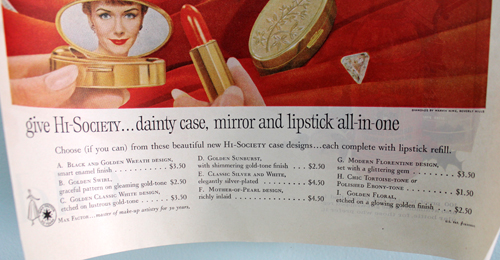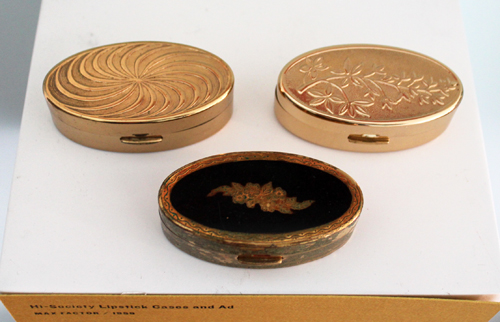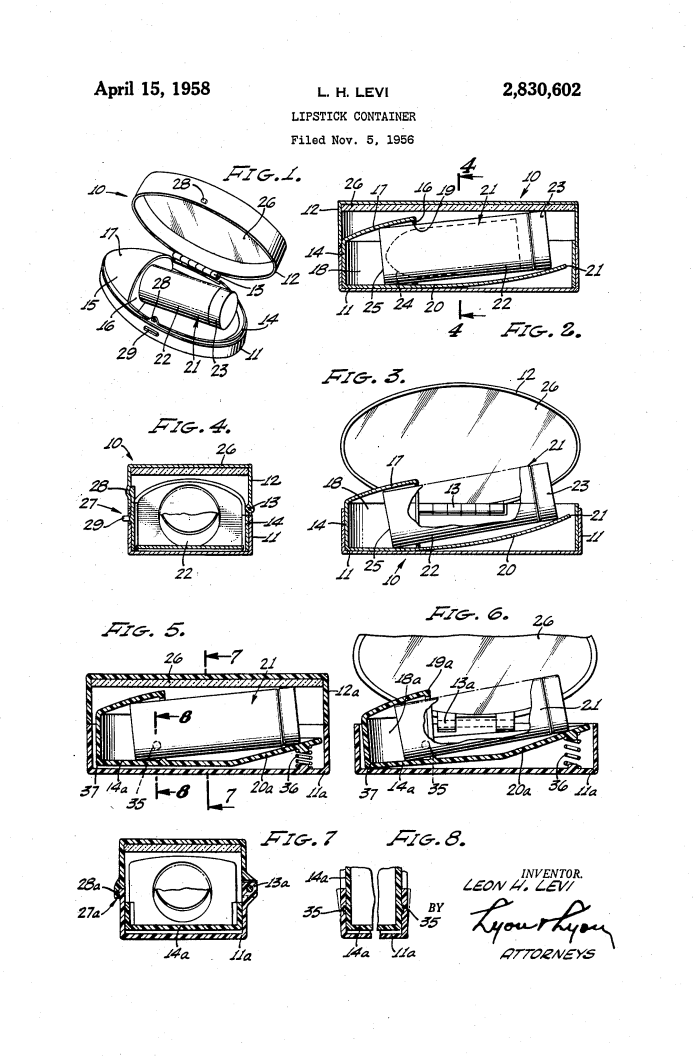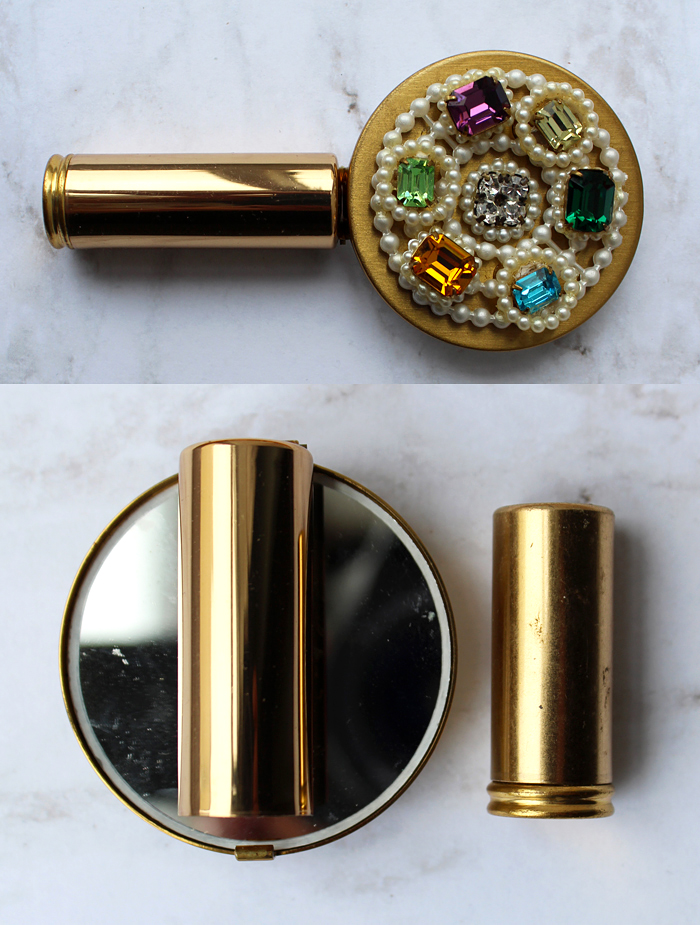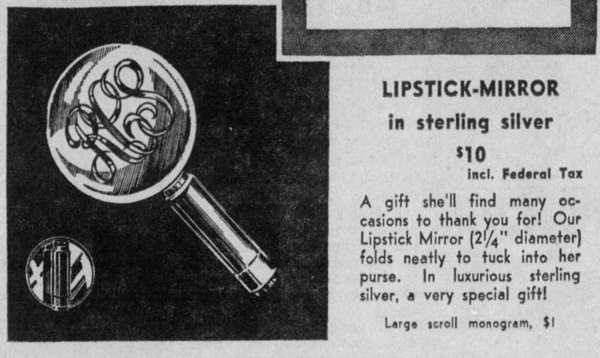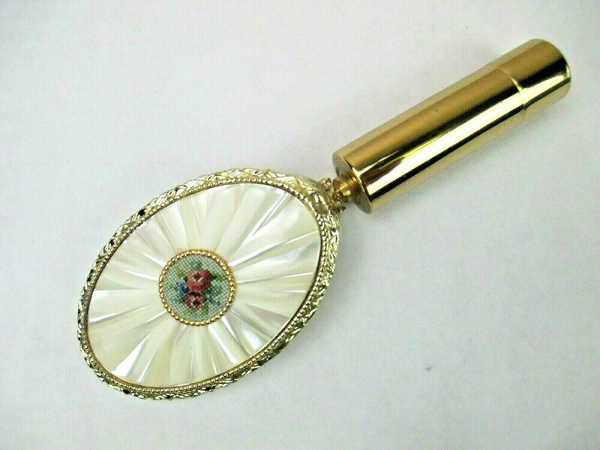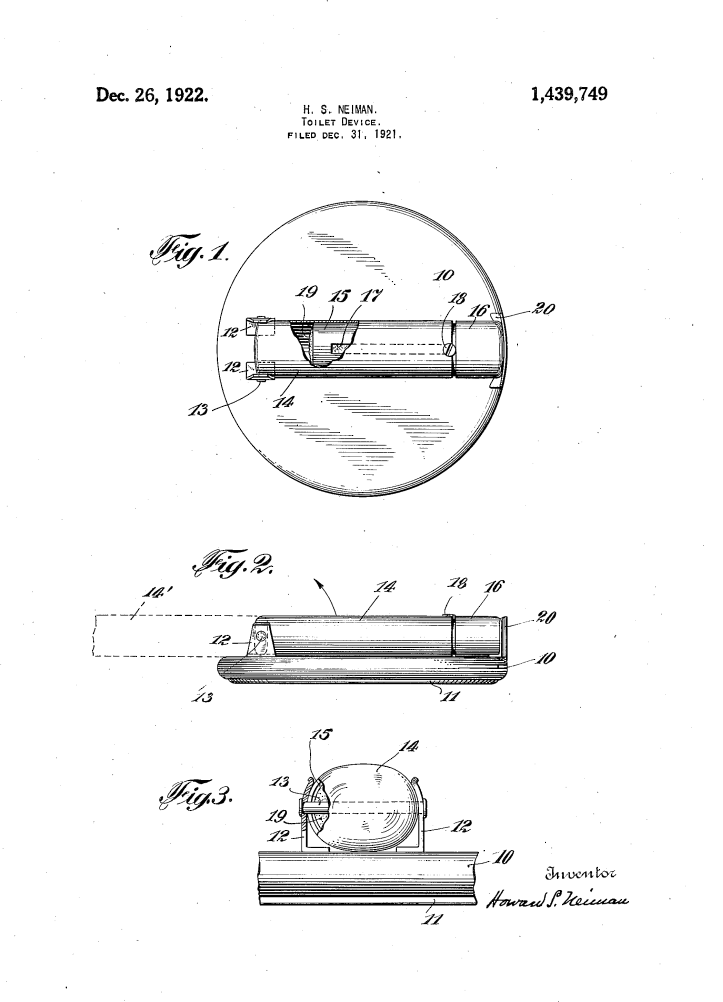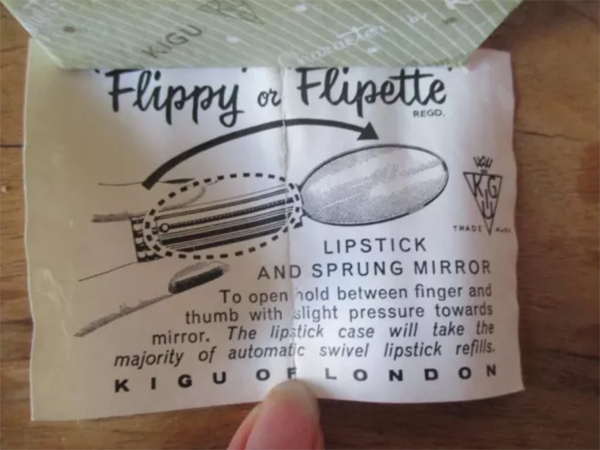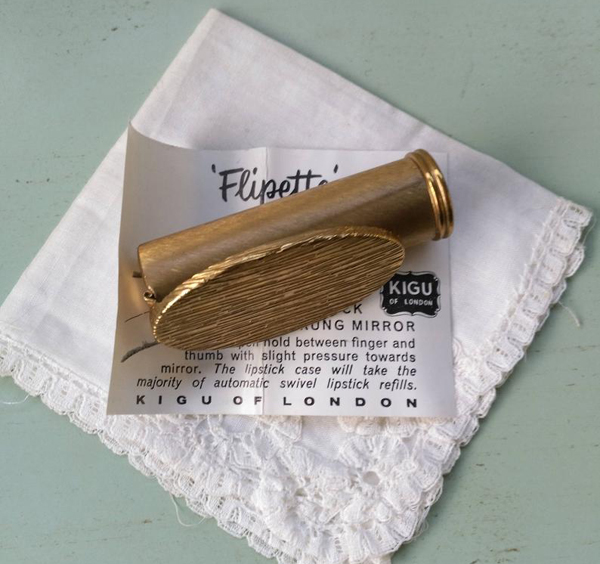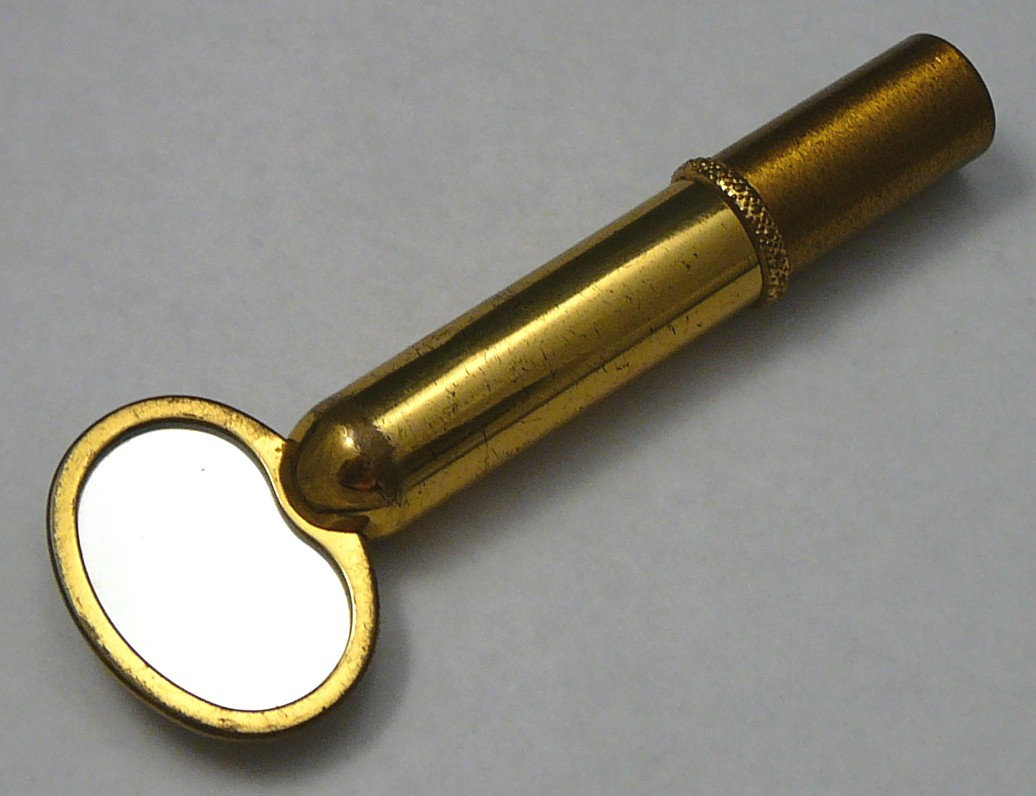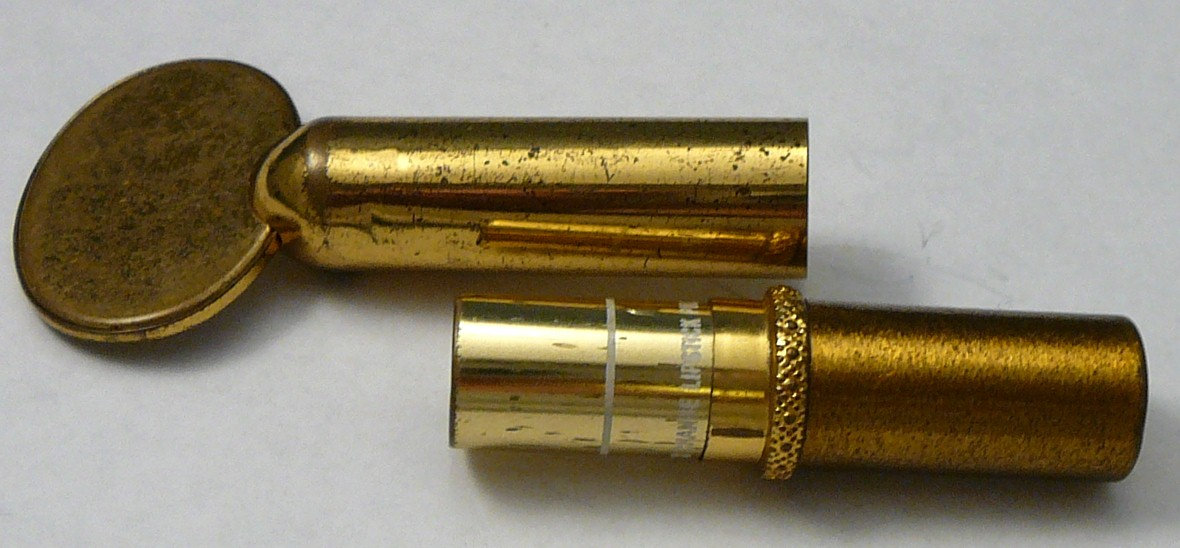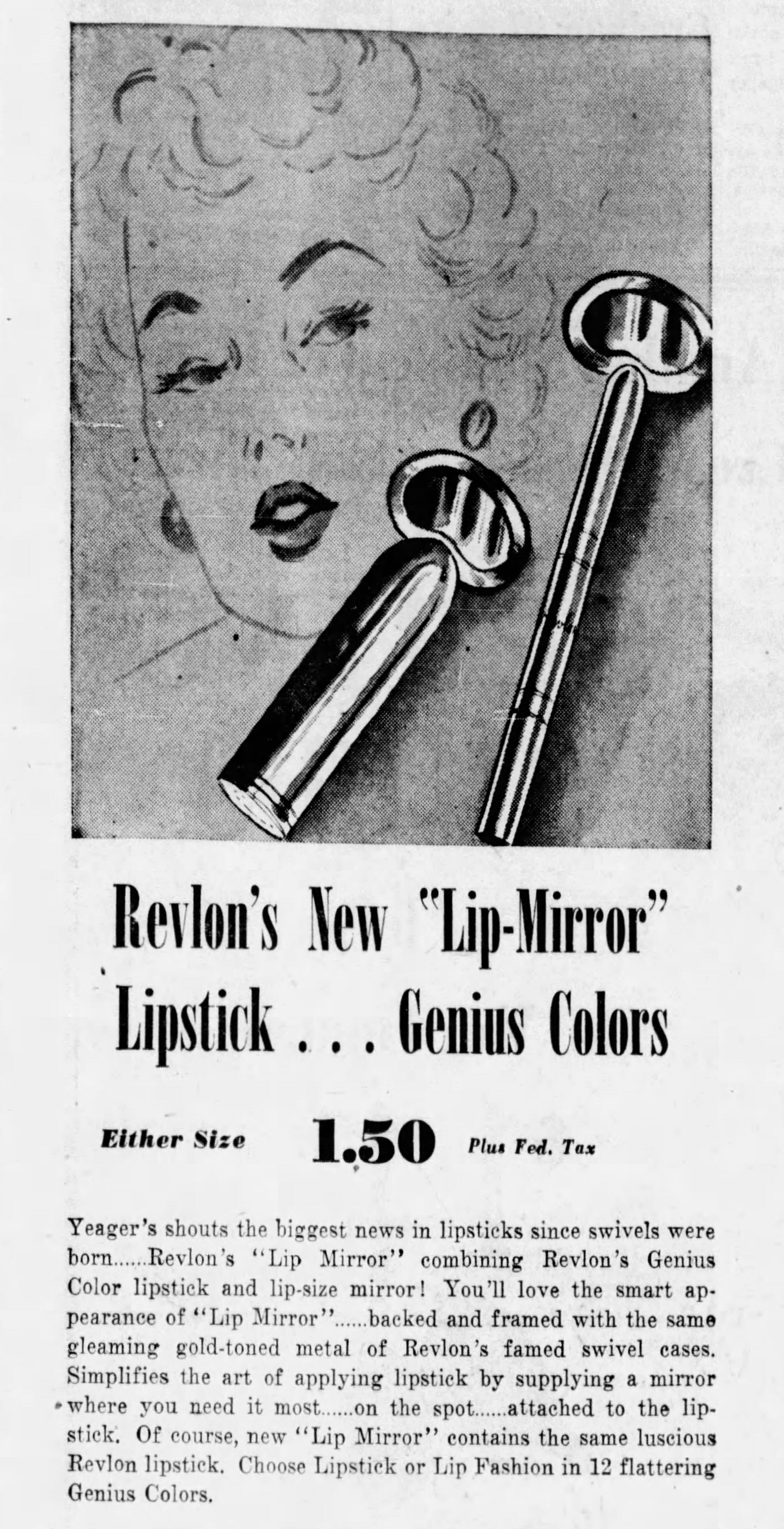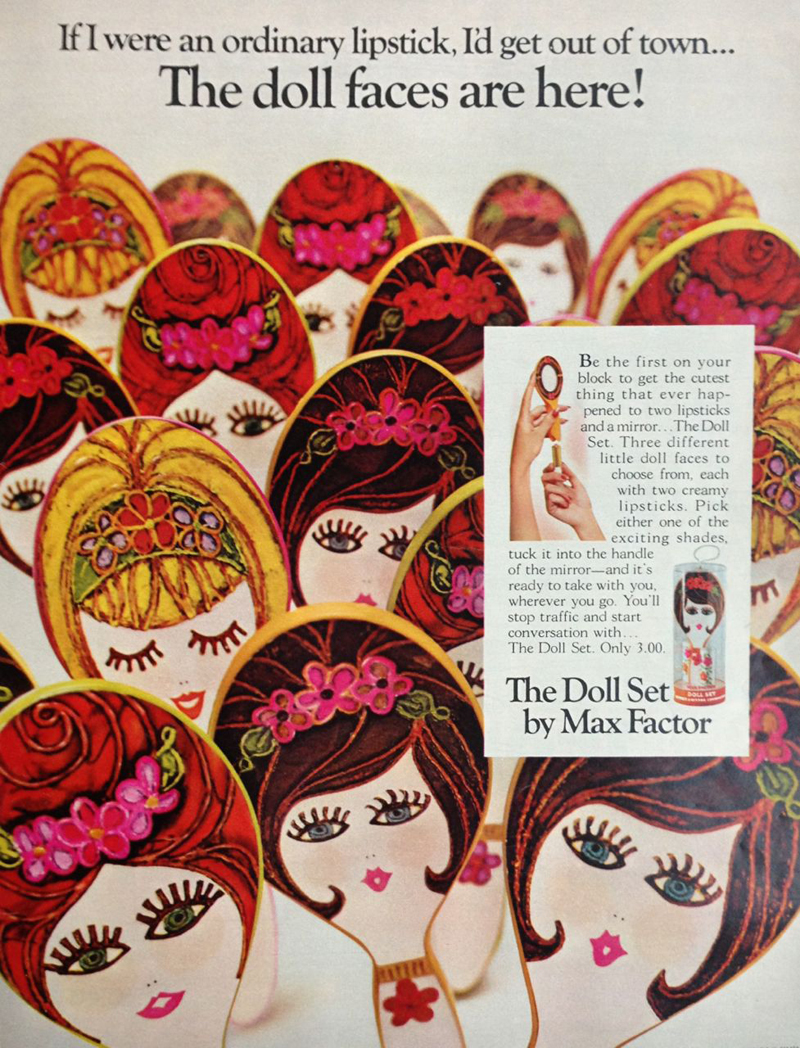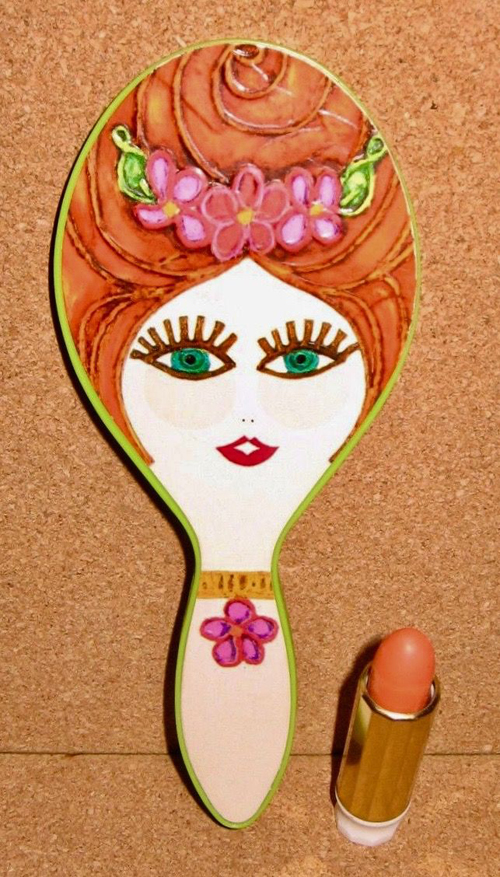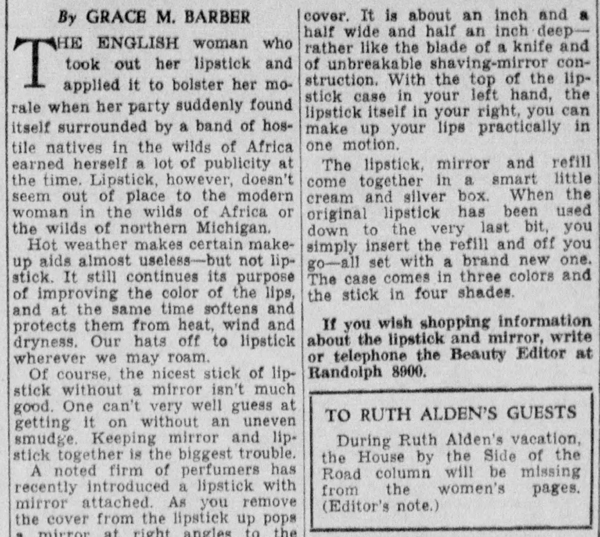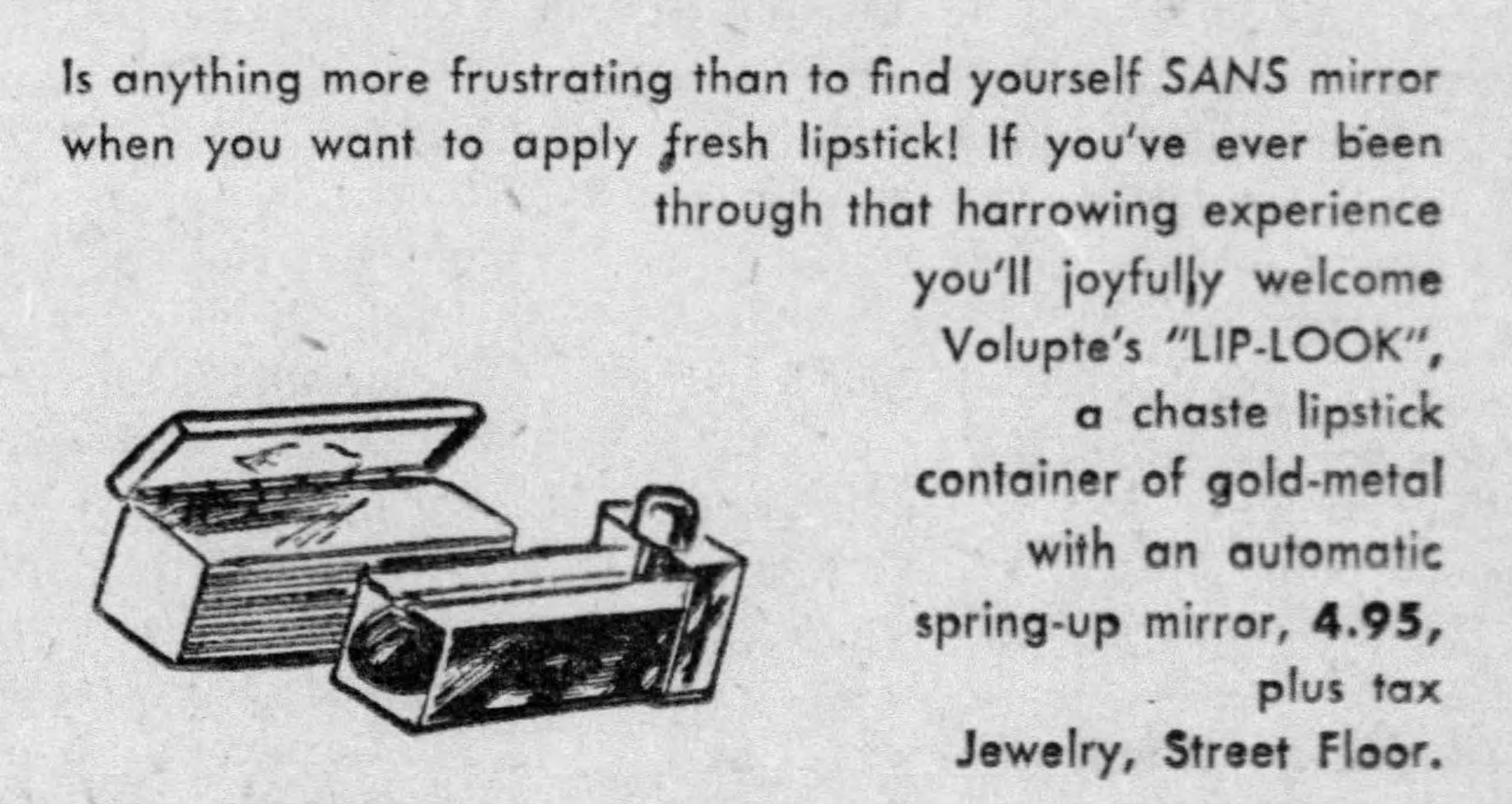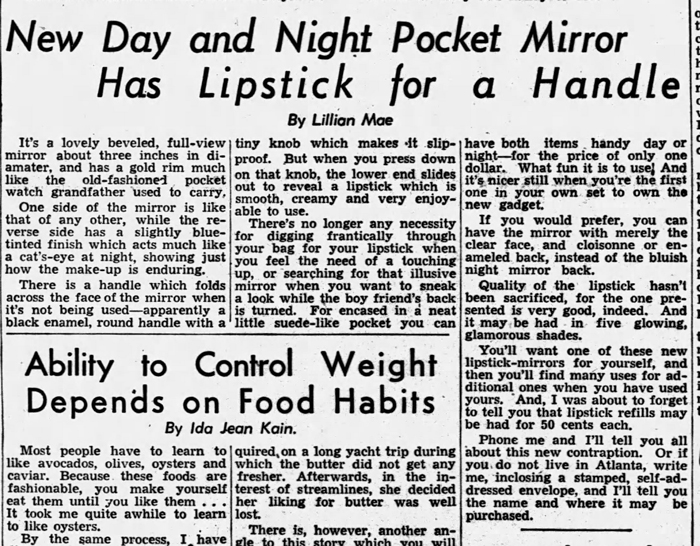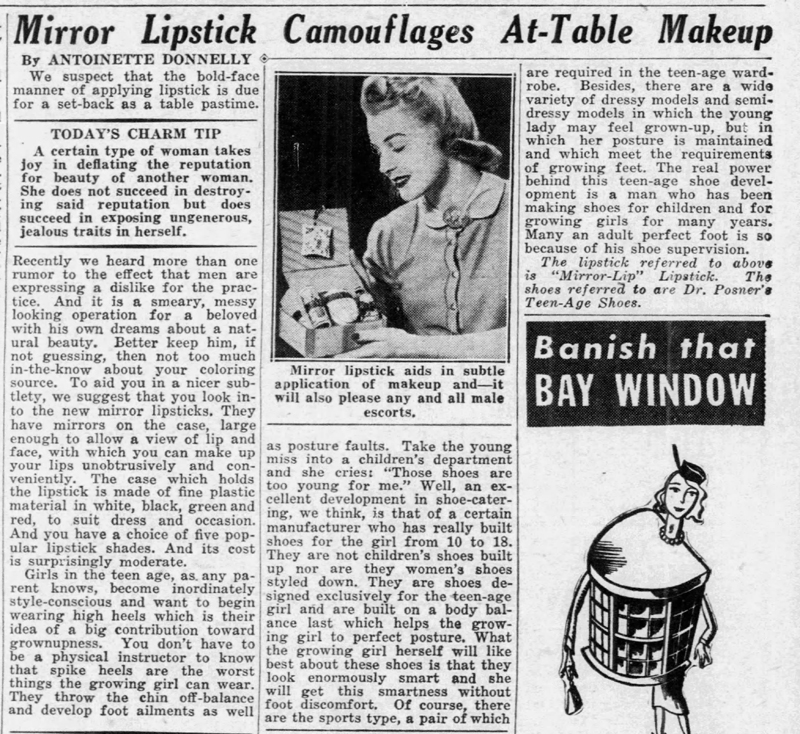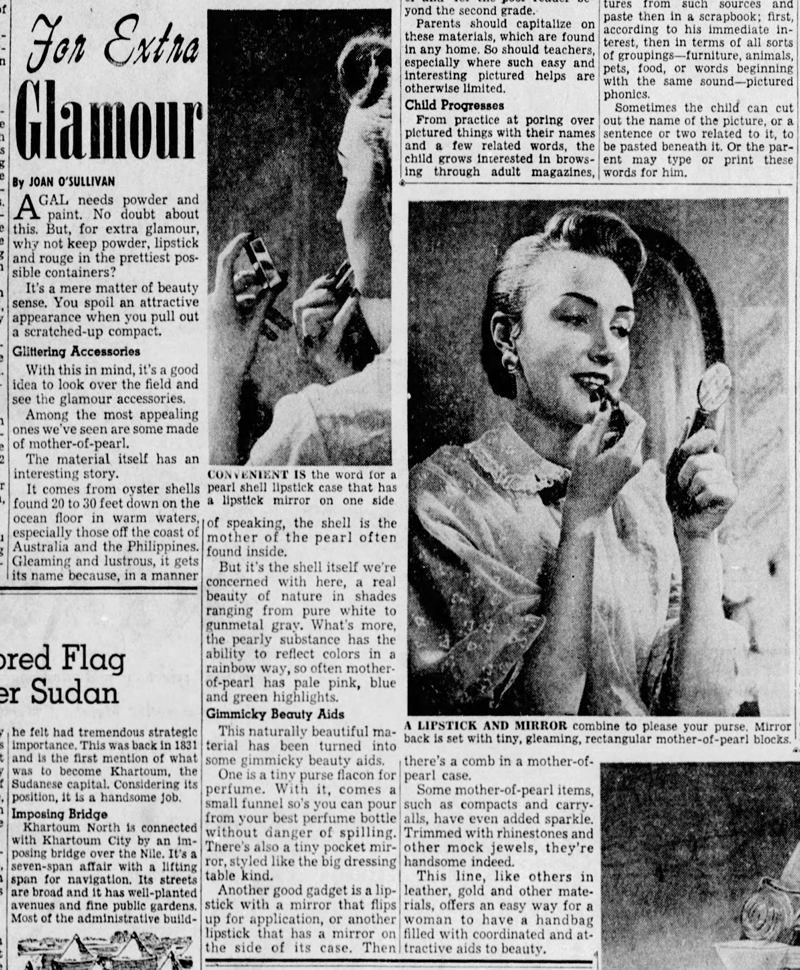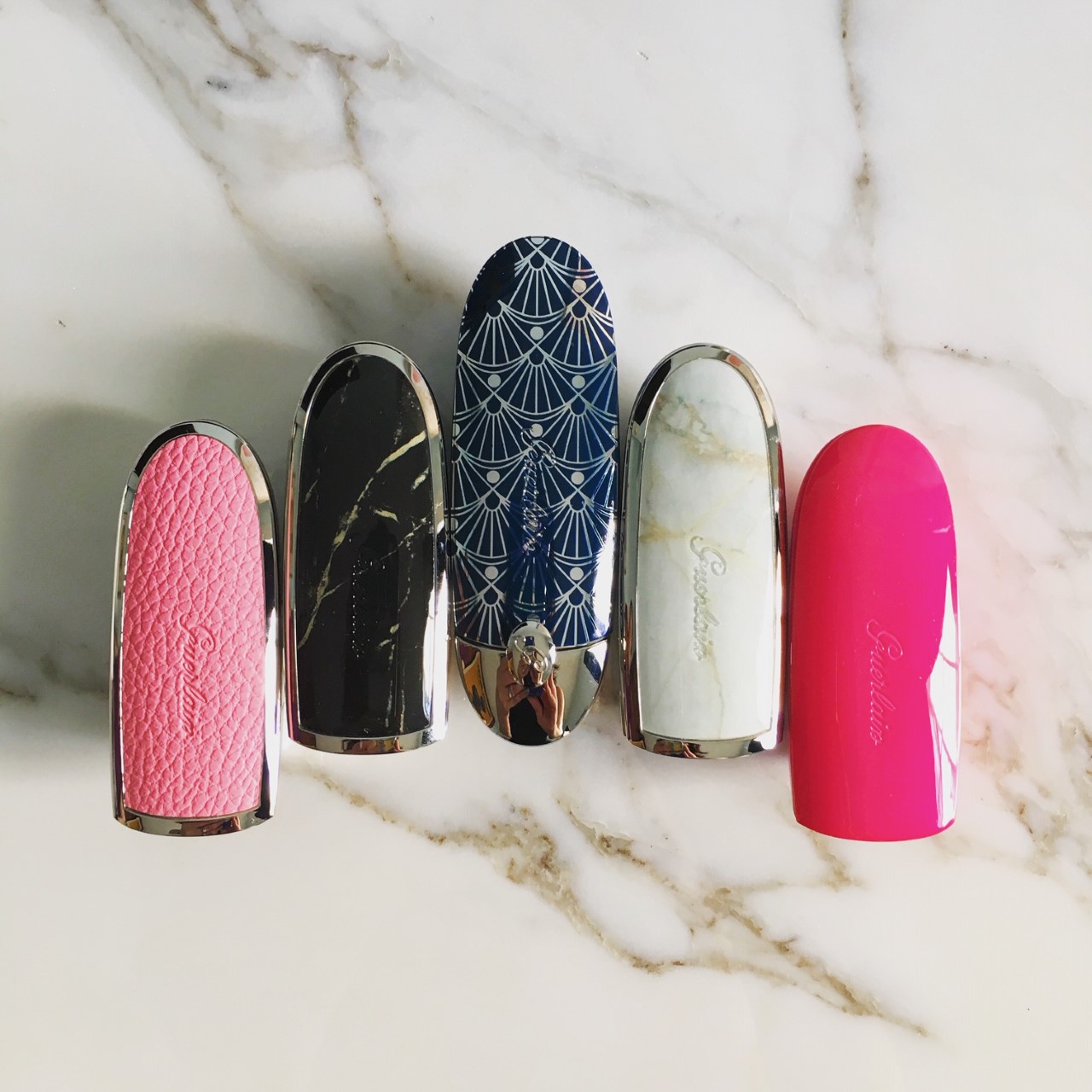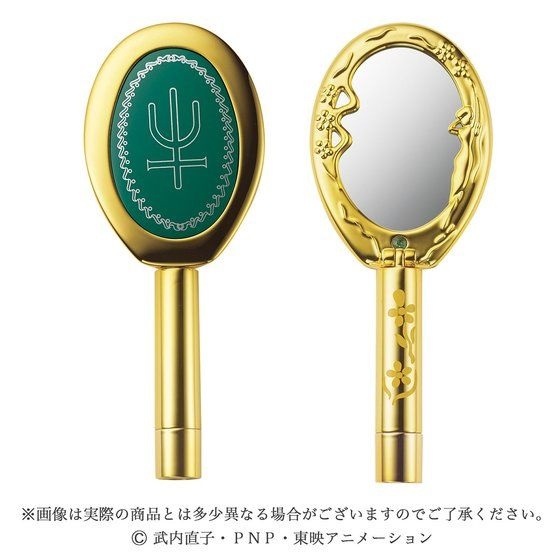As with lipstick holders and tissues, another piece of makeup ephemera has seem to gone nearly extinct: the built-in lipstick mirror. Sure, there are still some run-of-the-mill fabric and leather lipstick cases with mirrors inside, and some contemporary companies have recycled the basic designs, but no current lipstick mirrors are as novel as their vintage counterparts. Today I'll take a look (haha) at the various vintage contraptions and mechanisms that allowed for a quick lipstick touch-up. As usual this exploration is not intended to be a comprehensive history of lipstick mirrors, but a brief overview and theories as to why they have mostly disappeared from the beauty milieu as well as the reasons they were even produced in the first place.
The simplest design consisted of a mirrored tube, favored by the likes of Avon and Flame-Glo.
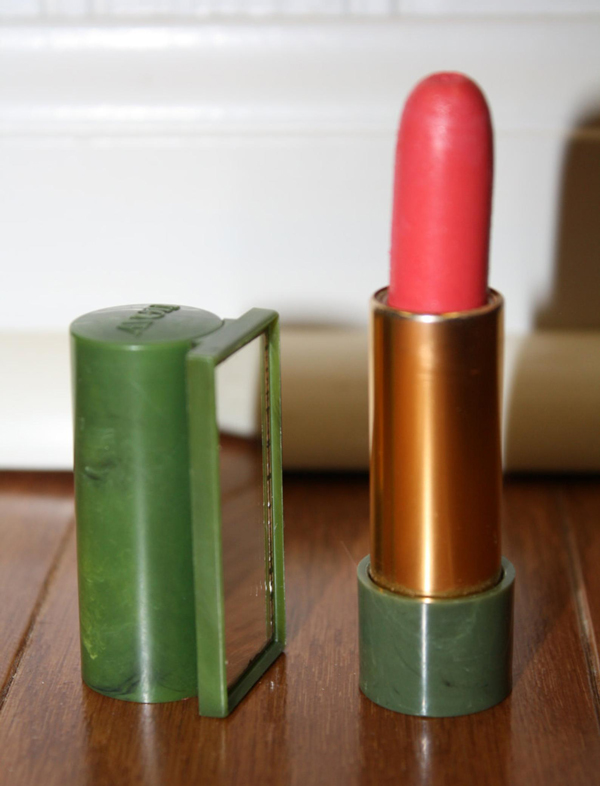
(image from etsy.com)
The second most basic and inexpensive option was the humble lipstick clip, which attached directly to the lipstick tube. The adjustable design meant that it could fit virtually any tube and was easily removable.
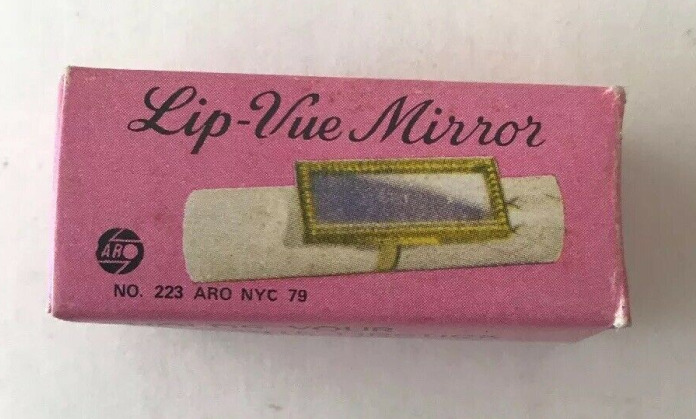 (image from ebay.com)
(image from ebay.com)
I purchased a couple of these clips for the Museum's collection. Here we have the "Looky" mirror, which was patented in 1957, and Compliments, which most likely dates to around the same time.
The only design flaw with these types of mirrored tubes and clip-on mirrors was that they would be easily smudged since the mirror was exposed. Enter the folding lipstick mirror and clip! Elizabeth Arden's Rolling Mirror lipstick debuted in 1959, and while I couldn't find an exact date for Stratton LipViews, they probably were released around the same time and continued to be sold until the early '90s.
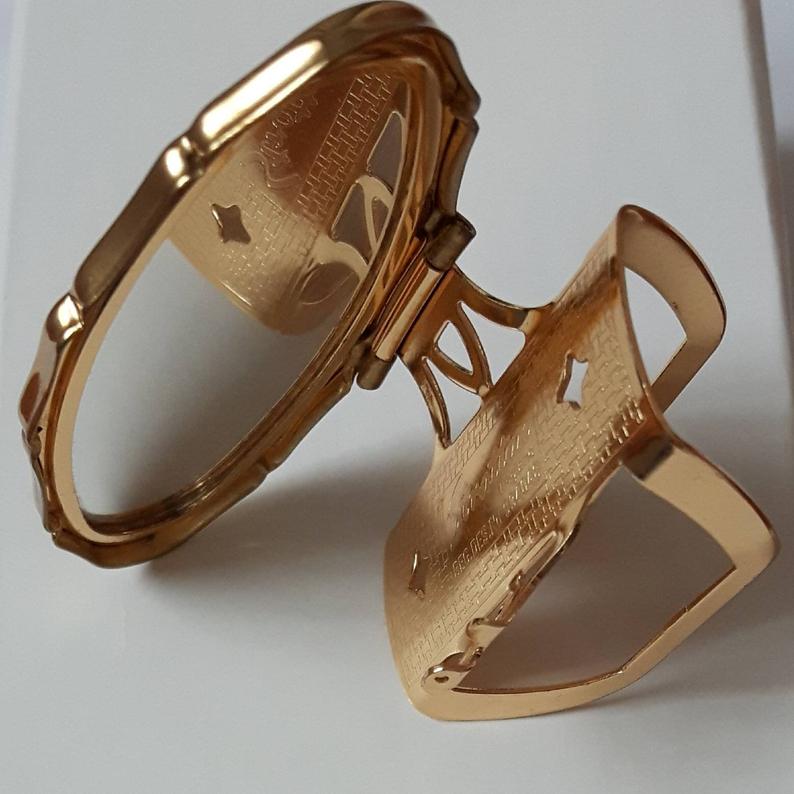
(images from etsy.com)
Avon also made a far less elegant plastic version.
The mirror could also be protected from smudges and scratches via a sliding mechanism instead of a folding one, as shown in this fan-shaped Stratton lipstick holder.
These next few will put a spring in your step. Spring-loaded, sliding cases in which the mirror popped up when the lipstick was opened were also quite popular. Shown here is Volupté's Lip Look, which dates to 1949-1950. Elgin, Elizabeth Arden and Kotler and Kolpit offered similar cases.
Given how many came up in my search for lipstick mirrors at Ebay and Etsy, it appears that the most widely available model of the spring-loaded variety of lipstick mirrors was a silver carved case accented by gemstones. They're unmarked, meaning no particular company patented the design and choice of metal. I believe they were mostly sold in department and jewelry stores.
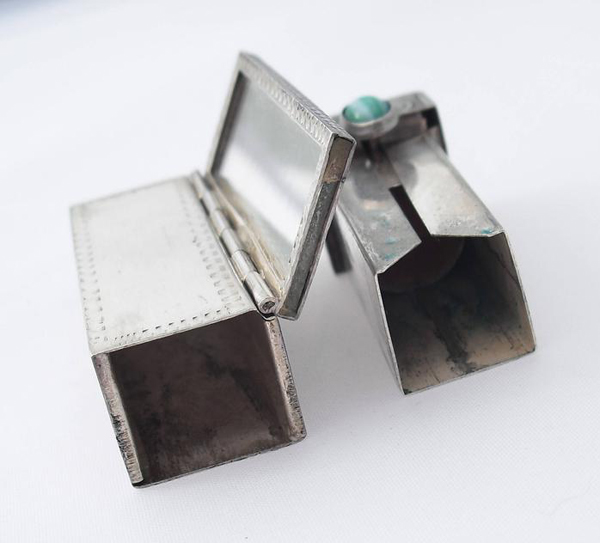
(images from etsy.com)
Despite the silver cases' ubiquity, I'd say the most recognized name-brand spring-loaded lipstick mirror was Max Factor's Hi-Society, which was heavily advertised from their debut in 1958 through approximately 1965.
You might remember I featured these in the Museum's holiday 2016 exhibition. I'm still hunting down all the designs, which actually isn't difficult given how many the company produced.
Next up is a more complex version of the folding mirror. Instead of a tube clip, this was an entire folding hand mirror with the lipstick hidden within the handle. Here's an unmarked, super blingy version. Stratton also made a bunch.
Here are some rather dainty petit point and floral versions by Schildkraut.
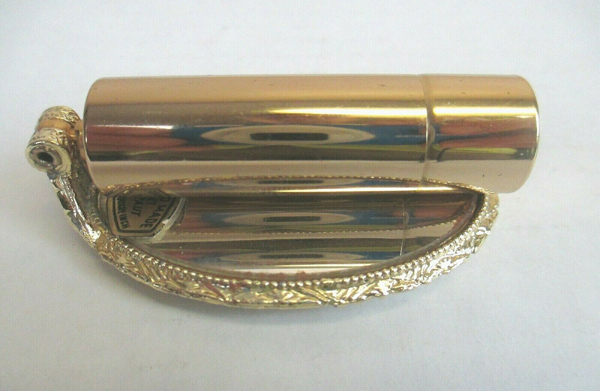
(images from ebay.com)
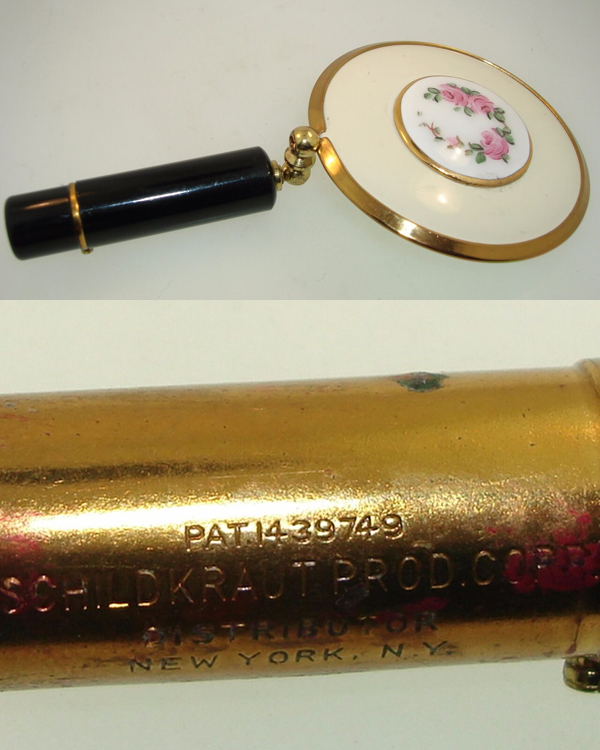
(images from ebay.com)
Schildkraut's represent possibly the earliest form of lipstick mirrors, judging from the patent.
The folding model's popularity continued well into the 1960s, as evidenced by Kigu's "Flipette".
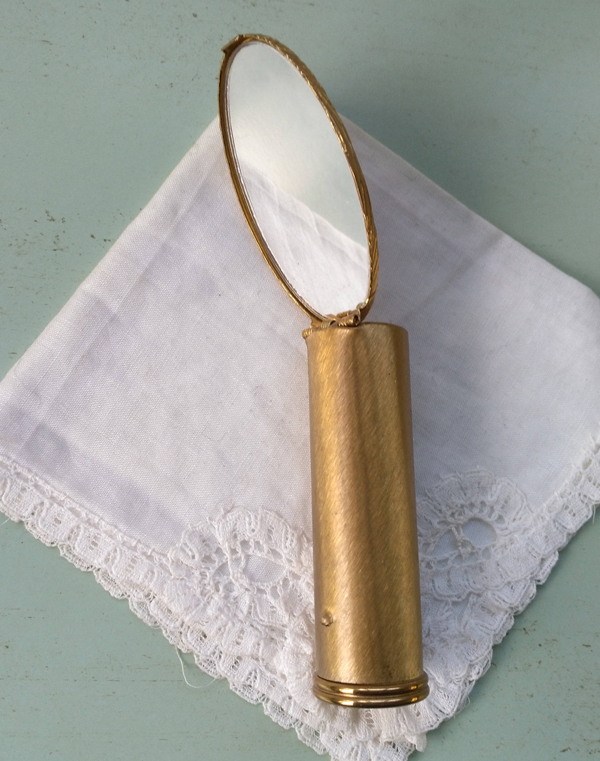
(images from etsy.com)
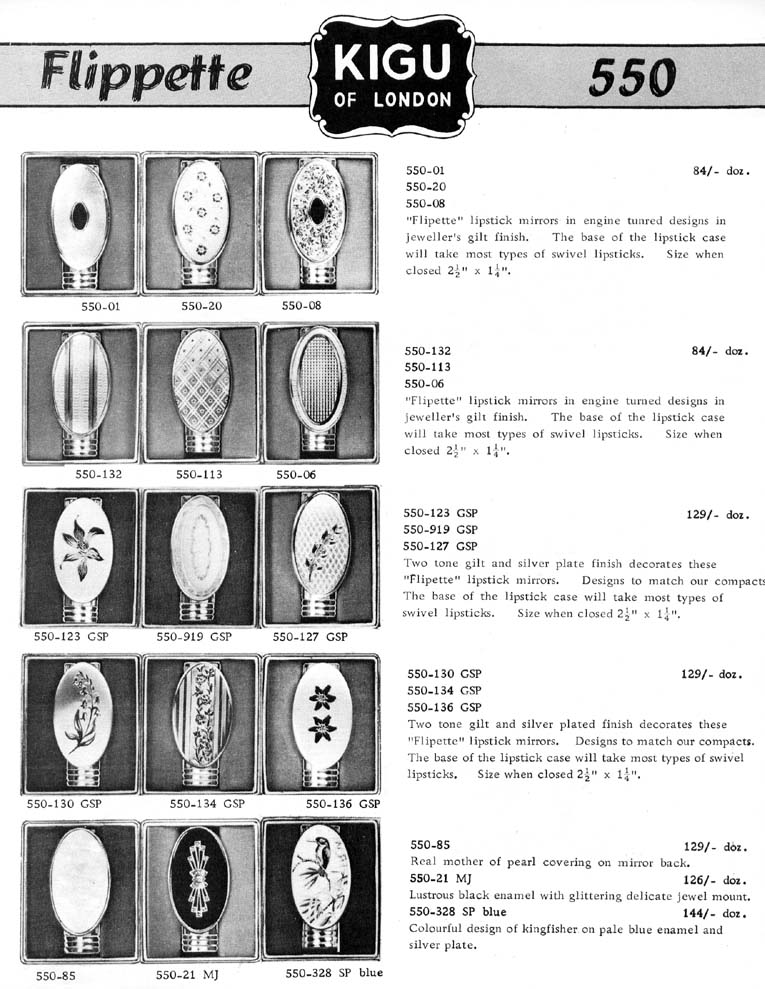
(image from vintage-compacts.com)
Finally, there are the handle inserts. This item from Revlon would appear to be a regular hand mirror, but the lipstick is cleverly hidden in the handle. It was introduced in 1950 as the "biggest news in lipsticks since swivels were born". How very exciting.
Of course, Max Factor upped the design ante with their "Doll Set" lipsticks, which were introduced in 1967.
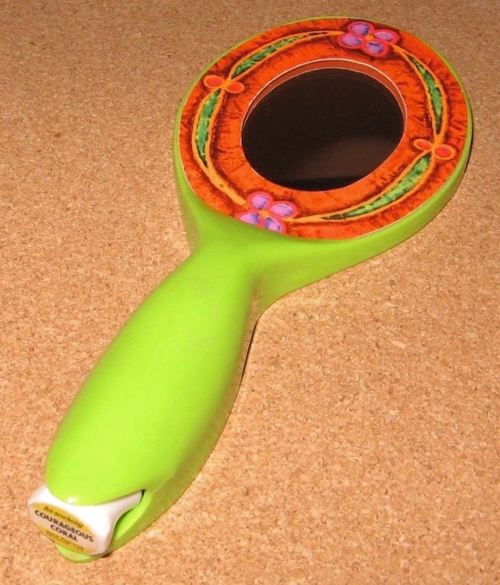
(images from pinterest)
Now that we have a good sense of the types of mirrors that were available, let's spend a little time thinking about why they were made, or at least, why the advertising claimed they were the greatest things since sliced bread. The first reason built-in lipstick mirrors were a necessity – again, according to the advertising at the time – was the ease provided by a fused lipstick and mirror. Presumably women who wore lipstick also would have also carried around mirrored powder compacts, which could be used for lipstick touch-ups. Fumbling around in your purse for a mirrored compact when you just needed to touch up your lips and not your face powder, apparently, was too difficult to handle on a regular basis. As this 1935 newspaper blurb states, "Keeping lipstick and mirror together is the biggest trouble." Oh, the horror! (Bonus points for the blatant racism at the beginning of the piece.)
Such a "harrowing experience" to not be able to find a mirror!
The second reason was that the lack of digging around for a mirror meant lipstick could be applied more discreetly, you know, for "when you want to sneak a look while the boyfriend's back is turned." (More bonus points for the weight/food shaming piece below the lipstick article.) Much like lipstick tissues, lipstick mirrors were meant to be used to avoid an etiquette faux pas.
This 1940 column takes the idea of discretion a step further. As we've seen time and time again, a woman's makeup habits are dictated by what men think. "We suspect that the bold-face manner of applying lipstick is due for a set-back as a table pastime. Recently we heard more than one rumor that men are expressing a dislike for the practice. And it is a smeary, messy looking operation for a beloved with his own dreams about a natural beauty. Better keep him, if not guessing, then not too much in-the-know about your coloring source." Heaven forbid a man actually see a woman mend her lipstick! Ladies, please keep your silly frivolous face painting to yourself so as not to ruin TEH MENZ' unrealistic expectations of so-called natural beauty. I can't roll my eyes hard enough.
Thirdly, one can't be seen with a beat-up compact. Women should always present the prettiest possible cosmetic cases when in public. Seriously though, at least this 1956 clip is straightforward in proclaiming that a lipstick mirror is merely aesthetically pleasing instead of a necessary accessory in the battles against flaunting your makeup application and a messy purse in which no separate mirror can be easily unearthed. Just a little dose of "extra glamour".
And of course, let's not forget that as part of their goal of making a healthy profit, beauty companies are forever trying to invent another superfluous gadget or product and declaring it the next must-have. Perhaps lipstick mirrors were the mid-century version of vibrating mascaras. In any case, despite the lack of popularity for the built-in lipstick mirror as well as the cynicism of modern-day makeup wearers like myself, several brands forged ahead with attempting to resurrect the lipstick mirror over the past 20 years or so.
In late 1999, with much fanfare, Givenchy introduced their Rouge Miroir lipstick designed by by sculptor Pablo Reinoso. Reinoso became Givenchy's Artistic Director for their fragrance and beauty line shortly after the lipsticks' release.
The March 2000 issue of Vibe magazine proclaimed the sleek, futuristic design to be the height of convenience: "No more knives or rearview mirrors". Wait, who uses a knife to apply lipstick?!
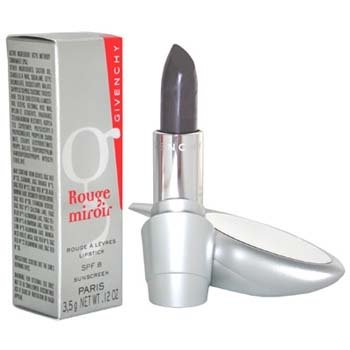
(image from amazon.com)
A year or two later, Estée Lauder launched their Pure Color lipstick line. I believe these mirrored cases came out in the mid-2000s when Pure Color lipsticks were at their height.
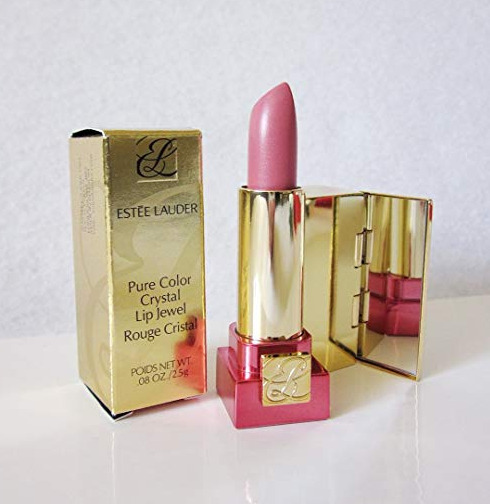
(image from amazon.com)
Some more recent examples I found include this mirrored tube from Kailijumei, a brand best known for their "flower jelly" lipsticks.
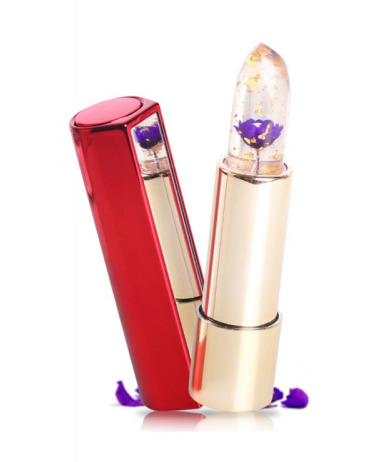
(image from kailijumei.com)
Guerlain's Rouge G series was introduced in the spring of 2018 and comes in a variety of collectible cases (and, duh, I'm working on acquiring them all). The mechanism is similar to Stratton's in that they won't close unless there's a lipstick bullet inside. While practical, it makes for quite the hassle to take photos of the cases only as they keep popping open. I have to tape them closed, which is a less expensive option than buying lipstick bullets to go in each case.
Finally, I spotted this folding lipstick mirror from J-beauty brand Creer Beaute, which was included in their 2018 Sailor Moon-themed collection.
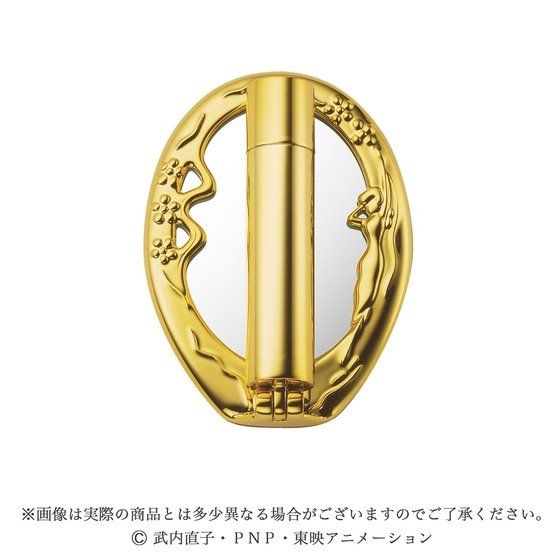
(images from alphabeauty.net)
Still, these designs are not nearly as common as their predecessors from the early-mid 20th century. Why did the popularity of the built-in lipstick mirror fade over time? One theory is that lipstick packaging with built-in mirrors is more expensive than non-mirrored packaging, and therefore, not as appealing to consumers. Guerlain's Rouge Gs, for example, cost $55 ($33 for the bullet and $22 for case) while their KissKiss lipsticks are priced at $37. Going further back in time, Elgin's spring-loaded mirrored case by itself was $5.50, while the price of an average lipstick was $1.10. Why pay for a mirrored lipstick case if you (most likely) already have another mirror available? Yes, you might have to dig around in your purse a bit, but at least it won't be lighter for having spent money on a lipstick/mirror combo. This theory could also explain why clip-on mirrors were seemingly everywhere, as they were the cheaper route to fusing lipstick and mirror.
Another theory for the continuing disinterest in built-in lipstick mirrors could be that for the last 5-10 years there's been increasing demand for less, or at least recyclable, packaging. While some higher-end brands are refillable, most lipsticks sold with a built-in mirror don't appear to have a refill option, and consumers may be less likely to buy a mirrored lipstick tube knowing yet another packaging component will eventually end up in the ocean. Plus, while the new designs are relatively slim, they're still bulkier than lipsticks without built-in mirrors. The majority of beauty consumers, myself included, don't want anything taking up more room in their purse or makeup bag.
Finally, I believe beauty consumers are savvier than they were in the early days of the industry and are less susceptible to marketing and gadgets. A built-in lipstick mirror may have been considered revolutionary in the '40s because swivel tube lipstick had been invented just a few decades prior, but by the '70s these mirrors may have seemed old hat. So certainly by the 21st century we know these designs are not truly a breakthrough, nor are they anything that would be considered a necessity. I featured no fewer than 6 Kailijumei lipsticks in the Museum's spring 2017 rainbow-themed exhibition, and just now noticed there were mirrors on the tubes. The fact that the mirror didn't even register with me, a person who enjoys re-applying her makeup and has spent countless hours poring over product packaging, until now when I'm actually discussing lipstick mirrors shows just how unnecessary a built-in lipstick mirror is. And again, the majority of beauty consumers is likely to be carrying a compact mirror anyway, rendering a lipstick with a built-in mirror redundant. We also know that makeup companies update older designs and market them differently to see what sticks. To cite Guerlain's Rouge G, the description at the website highlights how the user can select both the color and case to suit their individual taste. "Every woman is unique…choose your lipstick from a wide range of shades to match your look: from the most nude to the most extravagant. Choose your case from an array of styles – from the most timeless to the most trendy". Rouge G has the same basic mechanism as the spring-loaded lipsticks of yore – it's especially similar to Max Factor's Hi-Society with the array of designs – but the marketing focuses on the customizable aspects (a concept that has spiked in popularity over the last two or so years…I've been meaning to write something about the craze for name engraving/customization) rather than the newness and convenience of a dedicated lipstick mirror.
What do you think of the built-in lipstick mirror? Would you consider it a must-have? While I certainly appreciate the aesthetics, it's nowhere near a necessity for me.


